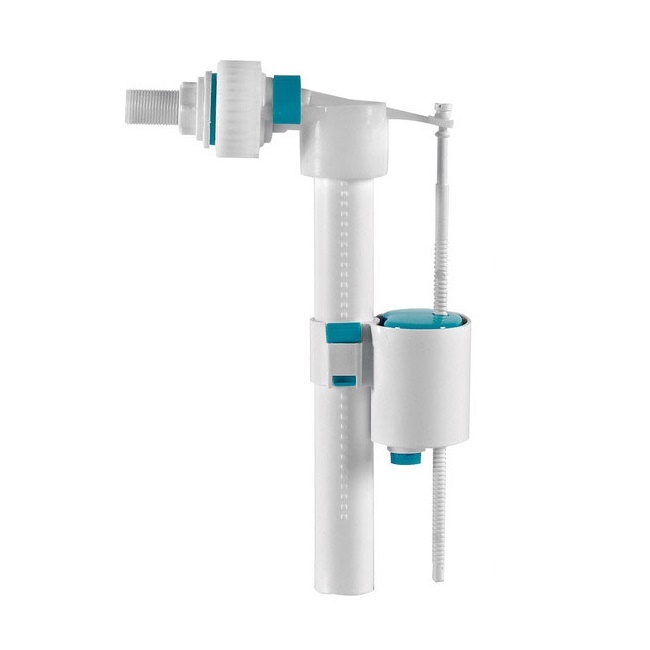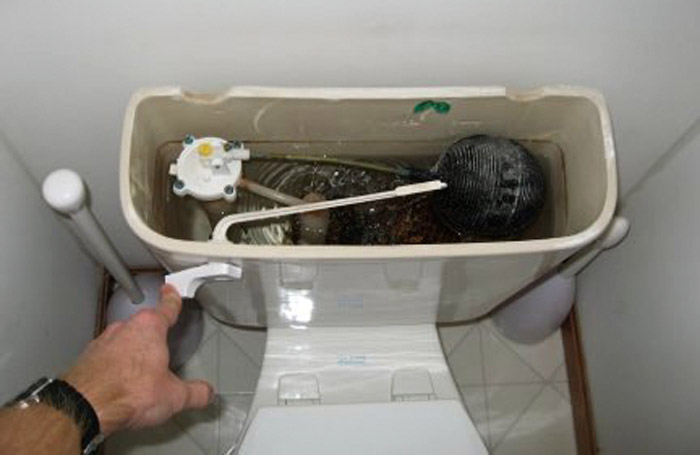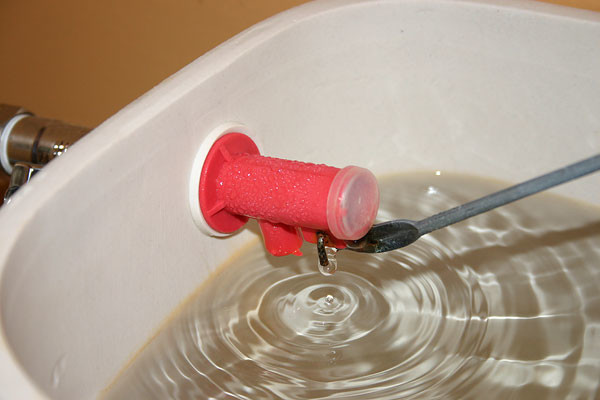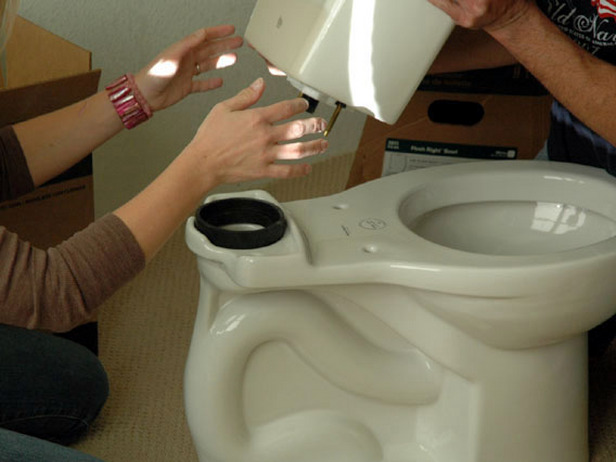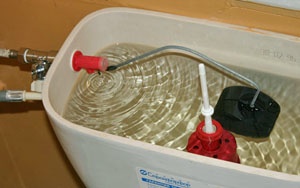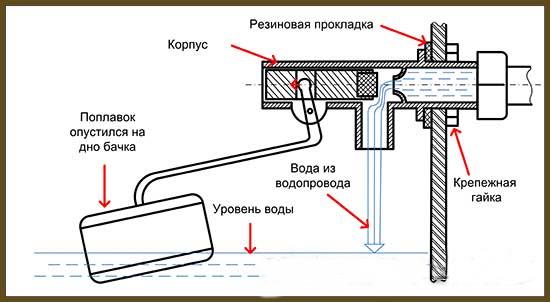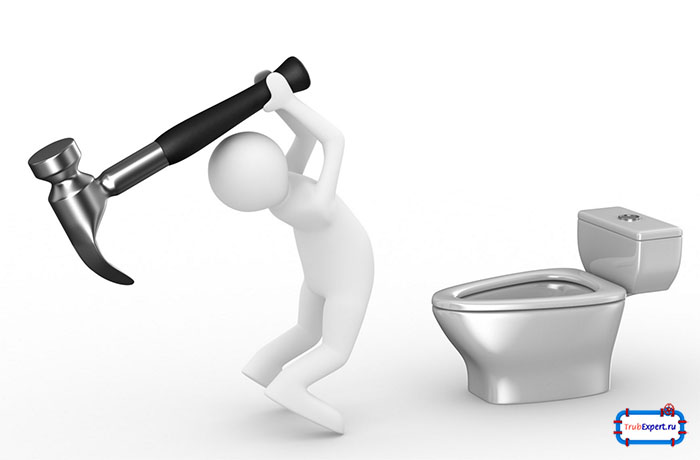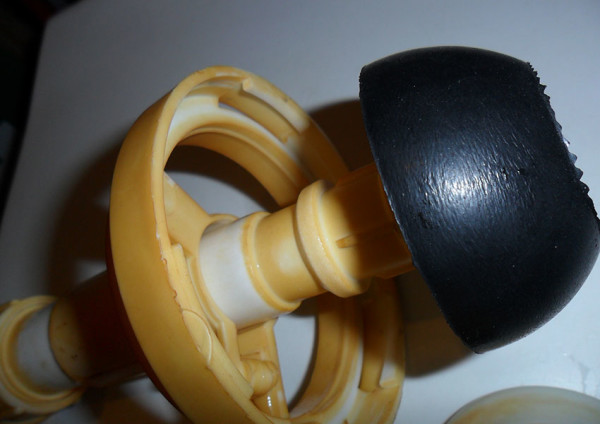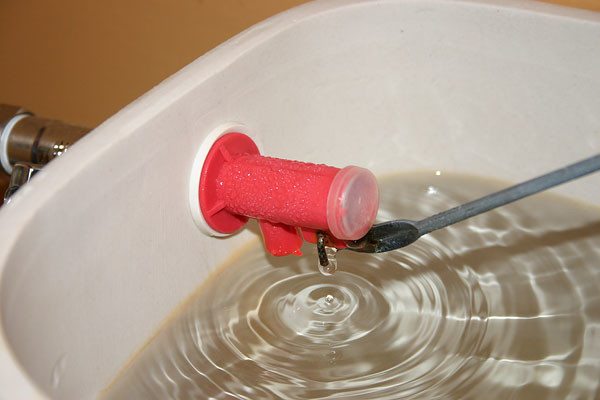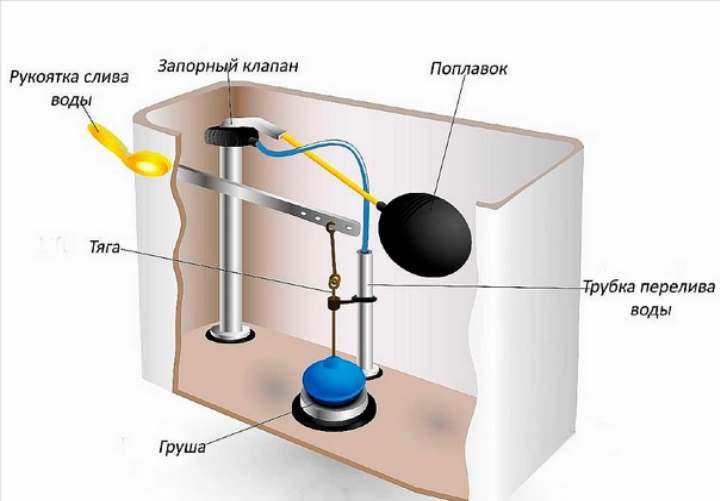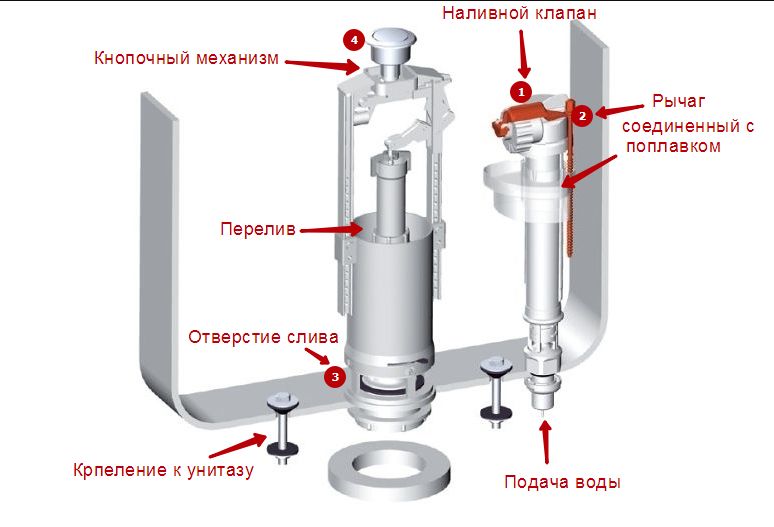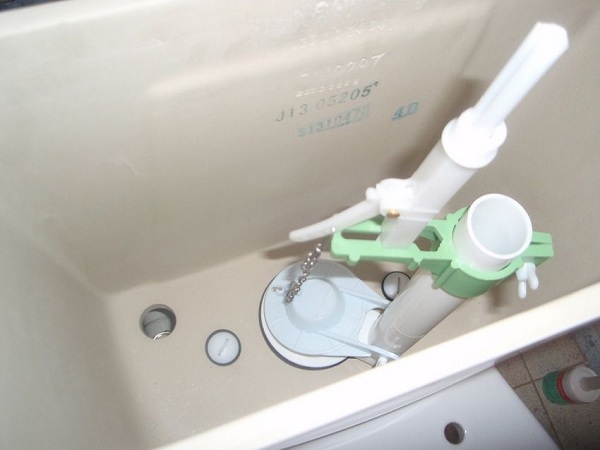The main causes of extraneous noise in the tank
To deal with a problem, you need to understand its source. In the case of noise in the tank during water intake, experts identify the three most common problems for which the toilet "sings":
Faucet gasket wear
A shut-off valve is installed in the toilet bowl, which is responsible for shutting off the water supply to the toilet bowl if necessary. Over time, the rubber gasket near the faucet begins to wear out and tear. When the flow of water passes through this damage, then there is a strong noise and hum.
Faucet tube missing
In each tank with an upper water supply, a shut-off valve is installed, which has a lower water outlet. It is in this area that a tube should be located, which is responsible for ensuring that water flows down the wall of the tank or is supplied to the very bottom when typing. If there is no such tube, a strong water pressure when collecting water will create noise.
Salt plaque
It's no secret that the water flowing through our plumbing leaves much to be desired. Impurities, salts, etc. settle on the inner walls of the tank, inside taps, pipes, floats and other mechanisms. This plaque prevents the normal supply of water, and as a result, a decrease in pressure causes extraneous sounds.



Causes of tank leaks and their elimination
If water does not hold in the toilet bowl, then this can be caused by two reasons:
Below we will take a closer look at the possible causes of malfunctions in these mechanisms and their correction.
Tank overflow
Tank overflow can occur for the following reasons:
-
Float position incorrectly adjusted
– adjustment can be carried out in different ways, depending on the design of the valve. For example, if the lever is metal, then you just need to carefully bend it. Plastic levers can have a ratchet or an adjusting screw. -
hole in the float
- in this case, the part can be temporarily sealed and then replaced. -
Float covered in mud
- as it is not difficult to guess, the part just needs to be cleaned of dirt.
Membrane failure
- if the water does not shut off in any position of the float mechanism lever, then there is only one way out - replace the shut-off valve. The price of the membrane is low and it is not difficult to find it on the market or in specialized stores.
Dismantling parts is not at all difficult. In some models, all fasteners are plastic, so dismantling can be done even without tools.
Valve not holding
If the water supply is shut off, but the flow does not stop, then the valve does not hold in the toilet bowl.
There can be two reasons for this error:
- Dry rubber valve;
- Debris got under the valve.
In any case, to fix the problem, you will need to dismantle. The design of the drain device may be different, respectively, the dismantling is also carried out in different ways. Most often, the mechanism is disassembled into two parts, as a result of which you can get the valve.

The instructions for fixing this problem are extremely simple:
- First of all, it is necessary to clean the valve and the drain hole from dirt;
- Then the device must be assembled and installed in place;
- If the toilet still does not hold water, you need to disassemble the mechanism again and replace the valve.
Other malfunctions
In addition to those described above, some other malfunctions may occur in the drain system, the following are the most common:
The connection between the tank and the toilet is leaking - in this case, it is necessary to completely dismantle the tank and replace all existing gaskets, including screw seals.
In the photo - dismantling the drain tank
Mechanical failure of any elements of valves - this problem can only be solved by replacing broken parts.
That's actually all the information that you need to know in order to independently eliminate such water breakdowns.
General information
Many people are afraid to “touch” the plumbing with their own hands and call specialists in the event of any breakdowns. However, the device of the drain tank is quite simple and understandable, thanks to which everyone can repair it without having any social knowledge. To do this, you only need the ability to handle elementary tools.
For some breakdowns, it may be necessary to replace the failed parts. In this case, it is necessary to dismantle the faulty elements and come with them to the plumbing store in order to select the appropriate repair kit.
Separately, it should be said about the repair of the wall-hung toilet cistern, which is a much more complicated procedure. This is due to the fact that the container is hidden in the installation, as a result of which it will be necessary to break the decoration of the room. The tank itself in this case may differ in shape from the traditional one, however, the principle of its operation is the same.
Shutoff valve device
The drain mechanism of the tank in the professional world of plumbers is called a shut-off valve. Before proceeding with self-repair, you should figure out how it works.
So, if an uninformed person opens the lid of the container, he will see only two details there:
float mechanism;
Below we will take a closer look at their device.
float mechanism
The float mechanism consists of two parts:
- Housing with a membrane that shuts off the water supply;
- A float with a lever that adjusts the position of the membrane in the housing.
The water filling level can be adjusted by the position of the float.
The drain mechanism device, as a rule, includes three main parts:
- Valve;
- Frame;
- Drain button with lever system.
The principle of operation of this device is quite simple - the position of the movable valve, located in a plastic case, is changed using a system of levers as a result of pressing a button. In addition, there is an overflow in the tank, which directs excess water into the toilet bypassing the valve, which helps prevent its overflow and, as a result, flooding of the apartment.
The water in the toilet bowl does not shut off. What can be done
29 comments
Hello, such a problem, in the tank at the outlet of the valve, water is leaking all the time. Those. it seems that the float does not press hard enough and the valve does not close, I tried to slightly bend the float so that it pressed harder, but this did not give the desired effect. The toilet bowl is old soviet.
I think that the valve is clogged, I did not check it myself. If it's really a problem with the valve, is it possible to fix it somehow on my own ??
I ask you to answer quickly, otherwise there is no drain in the toilet and it is possible to call the owner’s door from below)))))
I'll start by answering the question & where does the water drain &. If you look at the photo below, you can see that a tube sticks out in the tank. This tube is the overflow into which water is drained if the supply valve does not close. Thus, the water does not flow to the floor, but to the toilet.
If there is no such overflow tube, then another drain valve may be installed, and the overflow tube is made inside the valve itself. See photo below, arrows show
where does the water go.
If there is no overflow, which is extremely rare, then it is necessary to turn off the water and disassemble the supply valve.
Let's say that you have already unscrewed the flexible hose and removed the supply valve from the tank.
Next, remove the plastic plug:
After that, straighten and remove the &splint& with pliers:
Next, with this hand hold the valve body, and with the other hand, pull the float holder out of the valve body as shown in the photo:
It can be seen that the "lever" with a rubber gasket has pulled out, which locks the water.
If you now look into the valve body, you will see a through hole:
Water passes through this hole into the toilet bowl.And it is this hole that locks the "lever" from which the rubber gasket fell out.
Now we have the task of cleaning this hole if it is clogged. To do this, you will need a thin knitting needle, a large needle, or a suitable wire:
After cleaning, we look at our "lever" with a gasket:
Please note that the gasket is already pressed through. Usually such a gasket can no longer lock water
There are several ways to solve this problem:
4. Replace the valve.
3. Replace gasket
2. Level the dented area with a knife or sandpaper and carefully stick on a rubber band that can be cut out of a bicycle inner tube.
1. Turn gasket over. This is the easiest method and should be done first.
We take out the gasket from the holder
And turn it over
As you can see, on the other hand, the gasket is even and it will serve for some more.
Now reassemble everything in reverse order and don't forget to insert the &splint& or locking wire.
Here is such a simple thing.
The situation becomes more complicated when the float holder, inside the valve, rots. Then you can not do without replacing the supply valve.
It is not necessary to buy exactly the same, you can buy, for example, this one:
The most important thing when buying is to take a valve with a side feed and not with a bottom one. And then you can't take it all back. )
Constant filling of the tank with water
Repairing a toilet cistern with such a malfunction consists in aligning a displaced or skewed float lever. You can solve the problem by placing the lever below the inlet of the water supply pipe at a distance of 2.5 cm.
If you do not have certain building skills, you can only aggravate the situation
It is worth evaluating the condition of the float. There may be damage to the body of the element and the accumulation of water in it, which leads to weighting of the part. Eliminating a leak in the tank with such a malfunction helps to release the float from water and seal the hole, after which the element is placed in the place provided for it in the tank. To seal a hole or crack, plastic heated to a plastic state or a plastic bag always on hand, tightly fixed on the element, is used.
If water constantly leaks from the tank and it is possible to flush only after frequently pressing the button, the problem is a malfunction of the siphon membrane. To replace it, first the tank cover is replaced with a crossbar, to which the float lever is fixed by tying. The tank is freed from water, the fixing nut used to connect the container to the flush pipe is removed, and the siphon nut is loosened. After disconnecting and removing this structural element, the damaged membrane is removed, replacing it with a new analogue of a suitable size and identical shape. Then, in reverse order, perform the steps described above.
If there is damage to the flush button, if the toilet bowl does not leak, the faulty draft is repaired by disconnecting the broken part and replacing it with a piece of thick wire. In order for the toilet to work properly for a long period of time after repair, it is better to immediately install a new thrust.
When the problem is with the bowl
Problems associated with the breakdown of the toilet bowl itself are extremely rare. Usually, an unpleasant situation occurs due to improper fixation of the body to the wall or floor, as a result of which the toilet bowl leaks. When the structure is assembled (especially when choosing a built-in wall) it is quite difficult to solve the problem that has arisen, so you should take care of the correct installation at the installation stage, otherwise you will have to disassemble the complex structure, evaluating the condition of the gaskets and the quality of the connections.
In some cases, in order to eliminate a leak in the toilet, it is still necessary first of all to carefully examine the tank, since the constant formation of a puddle on the floor can be explained by an insufficiently tight fit of the pear, damage to the seat due to corrosion processes, improper adjustment of the valves or a violation of the tightness of the nut connection. In some cases, it is enough to simply replace the gasket or worn cuff with new elements or tighten the loose nut at the base of the overflow, for which the tank is first removed. For maximum reliability, a fixing clamp is additionally applied.
If water is constantly flowing in the toilet, but repairs are not carried out immediately after a malfunction is discovered, limescale may form on the walls. A mixture of water and citric acid, which is applied to contaminated areas and left overnight, allows you to eliminate an unsightly formation. Similar steps can be performed to clean the tank itself.
Provided that the repair is carried out correctly, the tank and the toilet bowl itself will work properly for a long period of time, without requiring a complete replacement of the plumbing fixture. Do-it-yourself repair is an economical and simple option, so it is worthwhile to thoroughly study the problem and solve it using one of the methods suggested above.
Plumbing fixtures have become so commonplace in our apartments, houses, offices that their presence is taken for granted.
But some fifty years ago, most Russians did not even imagine that a “latrine” could be arranged inside a house or apartment - almost everywhere they used free-standing sheds installed above cesspools.
And today, malfunctions in the work of plumbing horrify the townsfolk - after all, without a normally functioning toilet bowl, the advantages of apartments are nullified.
One of the most common toilet cistern problems is a constant set of water that occurs due to the fact that water from the toilet bowl flows into the toilet bowl
or on the floor of the bathroom (read more about this situation). Naturally, such a state of affairs cannot suit anyone, because it leads to the following consequences:
-
Unreasonably high water consumption
. This natural resource is becoming more and more expensive every year, and with the widespread installation of water meters, constant water consumption leads to prohibitively high utility bills. -
Constant noise in the bathroom
. Taking into account the acoustic features of our apartments and thin walls that do not differ in high-quality sound insulation, the sound of running water does not contribute to the good mood of the residents, especially at night, when the overall noise level decreases. -
Faulty toilet cistern threatens to flood the bathroom
with all the ensuing (in the literal sense of the word) consequences, leading to the need to repair the flooring and, in the case of low-quality waterproofing of the interfloor ceiling, the underlying neighboring premises.
Trouble-shooting
So, your toilet tank is leaking - what to do in such a situation? First of all, you need to find out the reason why the leak occurs. There may be several options:
Wrong setting
Most often, the cause of constantly murmuring water in the toilet is banal - the float of the locking mechanism is incorrectly adjusted or its setting has gone astray
. As a result, the valve does not shut off the water before it enters the overflow system.
In this case, lower the float lower in level with the shut-off valve completely closed.
The setting process largely depends on the design of the locking mechanism:
old-style - in this case, the shut-off valve and the float connects the metal lever. To change the water level at which the valve will operate, you just need to slightly bend the lever with your own hands.
For some models of Soviet-style fittings, the lever is plastic, and consists of two halves connected by a plastic bolt. In this case, you need to loosen the bolt, change the angle between the levers, and then tighten the bolt to fix them in this position;
modern sample - the position of the float changes relative to the lever by moving it. To do this, you need to apply some force or even press the spring locking mechanism.
As a rule, setting the float takes only a few seconds. The only difficulty may arise with the dismantling of the tank cover.
Usually, to remove it, you need to unscrew the ring framing the button. Old plastic tanks have clips on the sides.
Depressurized float
After adjusting the float, make sure it floats on the surface of the water and the locking mechanism works properly. If it turns out that the float is “submerged” or even immersed in water, it is useless to regulate it, since it has depressurized
.
In this case, this part must be replaced. As a rule, it changes along with the shut-off valves.
Therefore, the dismantling instruction looks like this:
- shut off the water supply;
- flush the available water into the toilet;
- unscrew the flexible hose nut;
- then unscrew the nut that secures the stop valve.
After that, you need to take the valves, and go with it to the nearest plumbing store to purchase a similar mechanism. Install the new part in reverse order.
Locking mechanism failure
If it turned out that the float is working and adjusted, but the toilet bowl is still flowing - what should I do? In this case, make sure that the stop valve shuts off the water.
To do this, follow these steps:
- drain the water from the tank;
- raise the lever with your hands until it stops;
- see if water is flowing through the valve.
If water continues to flow after lifting the lever, then the shut-off valve is defective. In this case, it must be dismantled according to the scheme described above.
In principle, you can try to disassemble the valve and replace the rubber bands. But finding a repair kit for sale is not easy. Therefore, as a rule, the best option is to buy a new valve.
The price of valves with a float ranges from 100-500 rubles, depending on the type of design and the manufacturer of the fittings.
Water discharge system malfunction
All the malfunctions described above lead to the fact that water flows into the toilet through the overflow system. But, often the cause of the leak is the drain system. To check this, just turn off the water.
In the photo - an old-style plum pear
Often, the drain system leaks water due to a loose fit of the sealing membrane or pear. A similar situation can arise if any debris has fallen under the gum.
In this case, it is necessary to dismantle the drain mechanism, then rinse it, and also wipe the exhaust valve seat (the place where the pear fits to the outlet). The dismantling process depends on the type of mechanism
.
For example, if a toilet bowl with a button leaks, i.e. fittings are modern, then just grab it with your hand and turn it counterclockwise. As a result, the body will come out of the hooks, and you can pull it out.
In old cisterns, to gain access to the pear and drain hole, it is enough to remove the lid. The drain mechanism is not fixed in any way.
Drain mechanisms with pears are more durable, so their replacement is very rarely required. However, keep in mind that in principle they can also cause leakage.
In, in fact, everything that I wanted to tell you about fixing a toilet cistern leak.
Lack of water in the tank
Not always a malfunction of the plumbing system leads to the fact that the toilet is flowing. Sometimes there is an impossibility of draining water due to its absence in the tank (the reason is not related to the violation of the general water supply). If sagging of the handle or button is additionally detected, the connection between the siphon rod that performs the lifting function and the lever responsible for lowering is checked. We are talking about a wire link having a C- or S-shaped configuration. Usually, this link opens, so the restoration of the tank is possible after ensuring the connection is closed. Sometimes, to fix the problem, you need to put your finger into the siphon and point the plate up to exit the end of the rod.
The impossibility of draining water is also associated with its low level in the tank due to improper adjustment of the angle of the float valve lever. You can solve the problem in the presence of a plastic valve by tightening the adjusting screw with a screwdriver. If the valve is made of brass, for repair and adjustment, the float lever is slightly bent upwards or the fastening nut of the moving element is loosened, after which the fastening is shifted upwards.
Features of the toilet device
The assembled kit consists of a bowl and a drain tank, in which there are such elements as a float, a pear, gaskets, a lever system, fasteners, a toilet cistern lid, a flush button. The drain tank works on the principle of a hydraulic shutter. As a result of pressing the button, the flushing system is activated, and water is directed into the bowl to eliminate impurities. Upon completion of this process, a set of water begins through the hose attached to the container until it is completely filled. When the required level is reached, the button is ready to actuate again.
It is easier if the lid just rests on top of the tank and is supported by its own weight. In most modern models, the flush button is mounted from above into the lid that closes the tank. As a result, do-it-yourself repair of the drain tank is possible after disconnecting the button by removing the decorative ring holding it. The ring is gently pry with a sharp object and then removed. If there is additional fixation of the tank in the form of fasteners, they are unscrewed. If a flush system is provided in the form of a combination of two buttons, press both buttons in turn and rotate the device until it is completely disconnected.
To fix the toilet without creating additional problems, you need to handle the lid as carefully as possible, since it is not intended for sale in a separate form. Therefore, the appearance of a crack is fraught with a complete replacement of the toilet bowl.
As for the internal structure of the tank, in which there is a pear for the toilet and other elements, it may vary depending on the brand, so it is advisable to carefully study the instructions, paying attention to the characteristic features of the model
Ways to eliminate extraneous sound in the toilet bowl
As you can see, the reasons for the appearance of noise when water is filled into the toilet bowl are quite commonplace. Therefore, there will be no problems with their elimination. So, what to do if your toilet "sang"?
First of all, remove the stopcock and replace the old rubber band with a new one. Some people prefer to completely change the entire armature, but frankly, this is not at all justified;
The solution to the second reason is obvious, in order for your toilet to stop making noise, you need to install a tube on the faucet. Since the standard inner diameter of the faucet in the tank is 5-8 mm, you can pick up a suitable tube at any hardware store;
It is possible and necessary to fight plaque, otherwise the service life of your plumbing will be significantly reduced. Fortunately, salt deposits can be removed very easily and quickly. It is enough to pour a descaler for washing machines or ordinary table vinegar mixed with baking soda into the tank. A few hours is enough for the plaque to decrease, and the noise when collecting water to completely disappear.
Someone else's experience proves that the above actions perfectly help to cope with extraneous sounds in the toilet bowl. Try it and you, and very soon the annoying noise will cease to cause discomfort.
